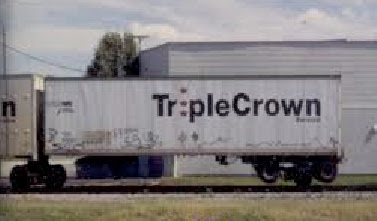Tuesday, September 10, 2013
NJ Transit Converting Diesel to Straight Electric Mode
At 2:28 the dual mode ALP-45DP pulls a passenger train in diesel mode. At 3:09 the pantogrph rises to convert to electrical operation.
At 5:48 another train pulls in by an ALP-45DP in diesel mode. At 6:23 the pantograph rises for conversion to electrical operation.
Electrification Clearance for Double Stack Container Freight Trains
Electrified railroad lines have adequate clearance for double stack freight car operations. Pictured is the R1 SEPTA line in the vicinity of Philadelphia. The demonstrated clearance is on a former Reading Railroad electrified line now owned and operated by SEPTA.
From the top of the rail to the top of the double stack container is no more than 20 feet and 3 inches.
See: www.ttx.com/equipment/listing/intermodal/double-stack-wells.aspx/
Saturday, September 7, 2013
Pittsburgh to Harrisburg Electrification
Mr. Joseph R. Marchinchin recently published in the October 2013 issue of TRAINS Magazine an article entitled "Conrail's Electric Dreams." Mr. Marchinchin described the findings of an electrification study done in 1978. Estimated costs in current dollars for catenary, substations, communications, signal systems, civil reconstruction, design and engineering, construction management is $2,184,210 a mile.
A comparison cost estimate by the University of Pennsylvania's School of Design was published in a 2010 report entitled, "Making High-Speed Rail Work in the Northeast Megaregion - Shaping the Future Through Strategic Transportation Investments." The per mile cost estimate was $2,580,484 for electrification.
A comparison cost estimate by the University of Pennsylvania's School of Design was published in a 2010 report entitled, "Making High-Speed Rail Work in the Northeast Megaregion - Shaping the Future Through Strategic Transportation Investments." The per mile cost estimate was $2,580,484 for electrification.
Thursday, August 1, 2013
Idea for Alternative Rail Passenger Vehicle
 | |||||||||||||||||||||
| Roadrailer Chassis designed to carry 40 foot container. |
The Roadrailer system now uses a two axle, four wheel railroad wheel set. Note: sometimes the wheel set is referred to as a truck (USA) or bogie (Europe). The wheel set for the current Roadrailer vehicles operated by triple Crown Services is separate from the Roadrailer vehicle.
In 1980 the prototype vehicle pictured reflected the system used then. The railroad wheel set is one axle with two wheels. The wheel set was attached to the Roadrailer vehicle. The wheel set was lowered to the rail and the tires were retracted clear of the rail head. The vehicles then as now had a projecting flange at the front of th Roadrailer. A slot to receive the flange making the connection to couple Roadrailer a vehicle into a train was and is located at the rear of the vehicle.
Roadrailer vehicle advantages are that they have less wind resistance and weight in operations than conventional railroad intermodal equipment.
The Roadrailer container chassis never became part of Triple Crown Services. They rely only upon Roadrailer vans for their logistics business.
The current Roadrailer vehicle system has the ability to operate with the single axle design shown.
Subscribe to:
Posts (Atom)



